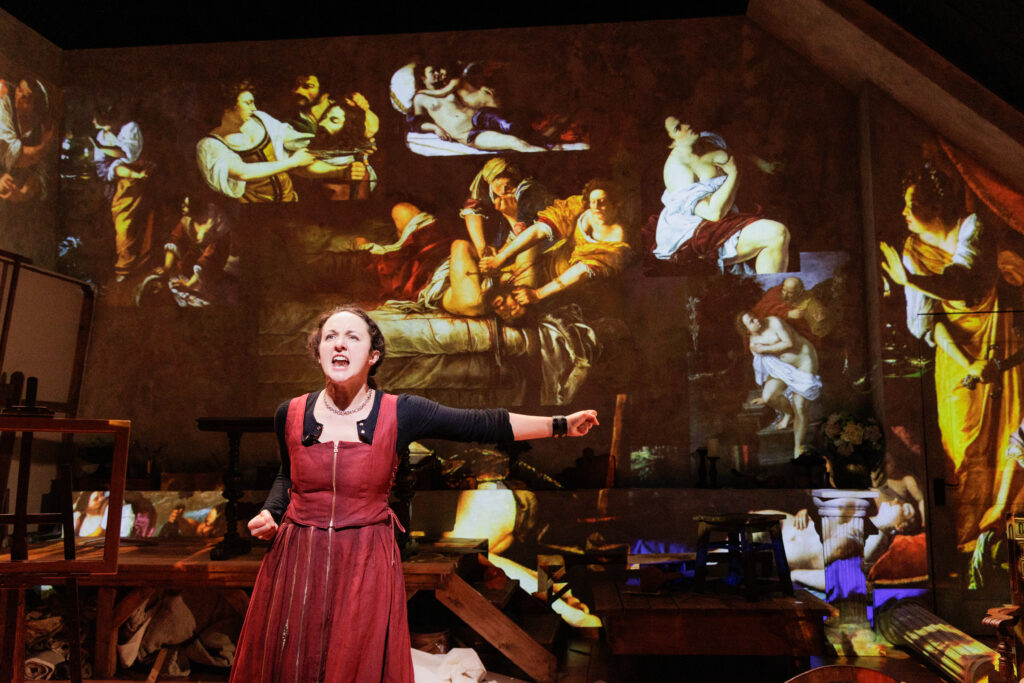The Greatest Female Painter of the Renaissance Makes Her Upper East Side Stage Debut
Artemisia Gentileschi learned from Caravaggio that paintings could happen at night, action disclosed by candlelight.

In 1971 a feminist art critic, Linda Nochlin, asked, “Why have there been no great women artists?” To that, any art lover worth his or her museum pass could exclaim: “But what about Artemisia Gentileschi?” The 17th century Baroque painter, a Roman, left posterity about 60 works, many of them with women at their centers. Now, a new play from Primary Stages, “The Light and the Dark (The Life and Times of Artemesia Gentileschi)” at 59E59, places her life and work in the spotlight.
Gentileschi began painting at 15. Her father Orazio was a competent painter albeit not one touched by the glory, and her most powerful artistic ancestor was the mad, bad, and dangerous to know Michelangelo Merisi da Caravaggio, who also happened to be an artist of surpassing originality, his backlit paintings noirish and cinematic. Gentileschi learned from Caravaggio that paintings could happen at night, action disclosed by candlelight.
The play’s title is therefore a reference to the visual alchemy Gentileschi learned from Caravaggio and then mastered for herself. “The Light and the Dark” is written by Kate Hamill, who also plays Gentileschi, and is directed by Jade King Carroll. Its set is the studio she shared with her father. Long before fashionable founders schemed startups at lofts at Williamsburg, artists worked where they lived. Paintings are projected on the theater’s walls.
Gentileschi’s greatest work is “Judith Slaying Holofernes,” from 1612, now on display at Naples. Its subject is the biblical tale where a Hebrew heroine slays an Assyrian general after lulling him into a drunken stupor. Carvaggio had executed a painting on the same subject 13 years before. Giorgian and Titian were drawn to Judith in earlier centuries, and Rembrandt and Rubens, Gentileschi’s contemporaries, would also turn to the tale.

None of those masters, though, had the kishkes to paint a scene like Gentileschi’s. Her Judith’s sleeves are rolled up, her forearms taut and alert. From Carvaggio she learned that light could itself be a character, charismatic and central. Her women, though — Judith and a maidservant — are determined where Caravaggio’s are diffident. They bend themselves to the task with a grit befitting the heiresses to Sarah, Rebecca, Miriam, and Esther.
In this case, Gentileschi’s art owed an unhappy debt to a wounded life. In 1599, one of her father’s colleagues, Agostino Tassi, raped her at home. He promised to marry her, omitting that he already had a wife. A seven-month trial ended in a rape conviction. Gentileschi testified while tortured with a “sibille,” ropes wrapped tight around her fingers. As she bled, she told Tasso, “This is the ring that you give me and these are your promises.”
Gentileschi was hardly obscure in her lifetime. She married and moved to Florence, the capital of the Renaissance. Her value was discerned by the Medicis, and she was the first female member of the Accademia di Arte del Disegno in the city of da Vinci and Michelangelo. Her fame spread as far as London, where Charles I — later beheaded in the English Civil War — invited her to the Sceptered Isle. She is thought to have died at Naples.
The true stars of “The Light and the Dark” are Gentileschi’s paintings, projected with luminous detail. These comprise not only “Judith Slaying Holofernes,” but also the “Susanna and the Elders” — her earliest work — and the nuanced “Self-Portrait as a Lute Player,” with echoes of Rembrandt. “Judith and Her maidservant,” now at the Palazzo Pitti, captures the moment after the slaying and invites the viewer into the conspiracy.
“The Light and the Dark” paints Gentileschi in a 21st century palette, after the style of #MeToo. She is a feminist avant la lettre, struggling to change history to herstory. Her final monologue in the play builds to, “Not for them, for us — Not my story but ours, And not their narrative to tell! We will try, in our brief time, to remake the world — Not just for us, but for those who are yet to come — For all the stories that are yet untold.” She is leaning in.
There are worse sins than anachronism, and it is likely that in carving her path through the 17th century, Gentileschi felt the same sting of injustice that women have felt for millennia. Her rape is a gash as shocking as a spill of red paint across a blank canvas. She towers over her attacker, though, not because her work is contemporary, but because it is timeless. She stuns not because her painting reflects our time but because it transcends time itself.

